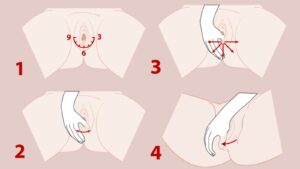Perineal massage helps prepare the perineum for childbirth. The perineum is the area of skin and tissue between the vaginal opening and the anus.
The goal of perineal massage is to make this area more flexible and stretchy, which can potentially reduce the risk of tearing or the need for an episiotomy (a surgical cut made to widen the vaginal opening during childbirth).
Importance of Perineal Massage:
Perineal massage is believed to have several potential benefits, including:
- Increased elasticity: Regular massage can help the tissues of the perineum become more pliable, making them better able to stretch during childbirth.
- Reduced tearing: By enhancing the flexibility of the perineum, there is a possibility of minimizing the extent of tearing that might occur during delivery.
- Improved blood flow: Massage can promote better blood circulation to the area, which may contribute to tissue health and healing after childbirth.
- Familiarity with sensations: Engaging in perineal massage allows the pregnant person to become more familiar with the sensations of stretching and pressure in that area, which can help during labor.
Learn how it’s done below!

Begin performing perineal massage at 34-35 weeks of pregnancy.
- Ideally, you would do these daily for 1-5 mins/day, but you can also do 3-4 times per week for 5-10 minutes.
- Wash hands thoroughly with antibacterial soap. Lay down comfortably with your back and knees well supported by several pillows.
- Apply water-based lubricant or natural oil on your thumb. Insert one thumb inside the vagina to the level of your 1st knuckle.
- Gently press downward and outwards (like a J) at the vaginal opening. Hold stretch for a couple 360 breaths as you feel the muscles release and soften.
- 360 breathing refresher video: click here! Repeat at both 1 knuckle and 2 knuckles deep inside the vagina.
- Alternative options:
- Have a partner perform perineal massage using one or both index fingers. Perform on your own in standing with one leg supported on a stool in a “Captain Morgan pose.”
- Perform in sidelying with your hand coming from behind you by using your pointer finger
Be sure to inform your PT if you feel discomfort or pain while performing these exercises!
